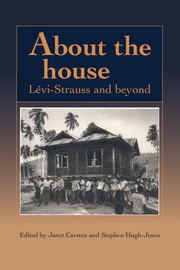Book contents
- Frontmatter
- Contents
- List of illustrations
- List of contributors
- 1 Introduction
- 2 Houses and hierarchies in island Southeast Asia
- 3 The resurrection of the house amongst the Zafimaniry of Madagascar
- 4 The hearth-group, the conjugal couple and the symbolism of the rice meal among the Kelabit of Sarawak
- 5 Houses in Langkawi: stable structures or mobile homes?
- 6 Having your house and eating it: houses and siblings in Ara, South Sulawesi
- 7 The Lio House: building, category, idea, value
- 8 Houses and hierarchy: the view from a South Moluccan society
- 9 Houses, places and people: community and continuity in Guiana
- 10 The houses of the Mẽbengokre (Kayapó) of Central Brazil – a new door to their social organization
- 11 Inside-out and back-to-front: the androgynous house in Northwest Amazonia
- Notes
- Bibliography
- Index
9 - Houses, places and people: community and continuity in Guiana
Published online by Cambridge University Press: 05 June 2012
- Frontmatter
- Contents
- List of illustrations
- List of contributors
- 1 Introduction
- 2 Houses and hierarchies in island Southeast Asia
- 3 The resurrection of the house amongst the Zafimaniry of Madagascar
- 4 The hearth-group, the conjugal couple and the symbolism of the rice meal among the Kelabit of Sarawak
- 5 Houses in Langkawi: stable structures or mobile homes?
- 6 Having your house and eating it: houses and siblings in Ara, South Sulawesi
- 7 The Lio House: building, category, idea, value
- 8 Houses and hierarchy: the view from a South Moluccan society
- 9 Houses, places and people: community and continuity in Guiana
- 10 The houses of the Mẽbengokre (Kayapó) of Central Brazil – a new door to their social organization
- 11 Inside-out and back-to-front: the androgynous house in Northwest Amazonia
- Notes
- Bibliography
- Index
Summary
This chapter considers the concept of the ‘house’ among the Carib-speaking peoples who live in the interior of the northeast corner of South America, a region often referred to as Guiana but politically divided between Brazil, French Guiana, Guyana, Surinam and Venezuela. This is a large area populated by numerous small native groups which, however, have enough in common for it to be possible to generalize about them with some degree of confidence.
In the absence of any clearly defined social structure among these peoples, ethnographers have often found settlements an invaluable hook on which to hang their descriptions. Thus, to a large extent, the house, which is often physically identical with the settlement, has been a crucial element in the theoretical and comparative literature of the region. The issues which this raises both in the wider South American context and in relation to Lévi-Strauss's ideas on house societies are taken up in the second half of the chapter.
There are within the region three main types of settlement pattern. These are the single communal house settlement; the nucleated village; and the ceremonial centre settlement. This chapter will concentrate mainly on the first two forms, but it is necessary to say something about the last since all the settlement patterns of the region have some common characteristics. The ceremonial centre settlement, of which the best reported example is that of the Akawaio, is characterized by dual residence with family groups owning dwellings both at a nucleated village with a ceremonial centre and at outlying garden sites and moving seasonally from one to the other (Butt Colson 1970: 36–42).
- Type
- Chapter
- Information
- About the HouseLévi-Strauss and Beyond, pp. 189 - 205Publisher: Cambridge University PressPrint publication year: 1995
- 9
- Cited by



